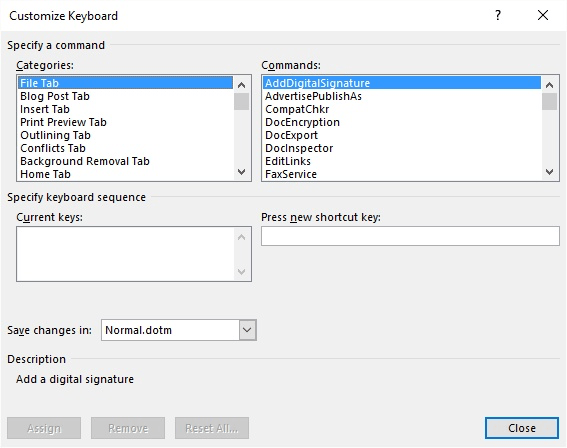Please Note: This article is written for users of the following Microsoft Word versions: 2007, 2010, 2013, 2016, 2019, 2021, 2024, and Word in Microsoft 365. If you are using an earlier version (Word 2003 or earlier), this tip may not work for you. For a version of this tip written specifically for earlier versions of Word, click here: Defining a Shortcut for a Macro.
Written by Allen Wyatt (last updated February 1, 2025)
This tip applies to Word 2007, 2010, 2013, 2016, 2019, 2021, 2024, and Word in Microsoft 365
Word allows you to assign macros or commands to specific key combinations. These key combinations are referred to as shortcut keys, and when used they result in the macro or command being executed.
When you first create a macro by recording it, Word gives you the opportunity to assign the macro to a specific key combination. If you later want to change the key combination, you can follow these steps:

Figure 1. The Customize Keyboard dialog box.
Note:
WordTips is your source for cost-effective Microsoft Word training. (Microsoft Word is the most popular word processing software in the world.) This tip (7120) applies to Microsoft Word 2007, 2010, 2013, 2016, 2019, 2021, 2024, and Word in Microsoft 365. You can find a version of this tip for the older menu interface of Word here: Defining a Shortcut for a Macro.

The First and Last Word on Word! Bestselling For Dummies author Dan Gookin puts his usual fun and friendly candor back to work to show you how to navigate Word 2019. Spend more time working and less time trying to figure it all out! Check out Word 2019 For Dummies today!
Got a macro that processes or uses styles? You definitely need to know how many styles Word has available in the ...
Discover MoreWant to give your macros a different name than they currently use? It's easy to do using the VBA Editor as described here.
Discover MoreNeed to know if a number in a macro is odd or even? It's easy to figure out with the simple calculation shown in this tip.
Discover MoreFREE SERVICE: Get tips like this every week in WordTips, a free productivity newsletter. Enter your address and click "Subscribe."
There are currently no comments for this tip. (Be the first to leave your comment—just use the simple form above!)
Got a version of Word that uses the ribbon interface (Word 2007 or later)? This site is for you! If you use an earlier version of Word, visit our WordTips site focusing on the menu interface.
Visit the WordTips channel on YouTube
FREE SERVICE: Get tips like this every week in WordTips, a free productivity newsletter. Enter your address and click "Subscribe."
Copyright © 2025 Sharon Parq Associates, Inc.
Comments